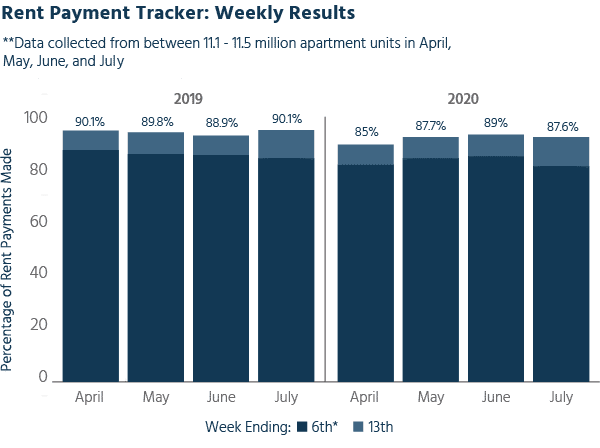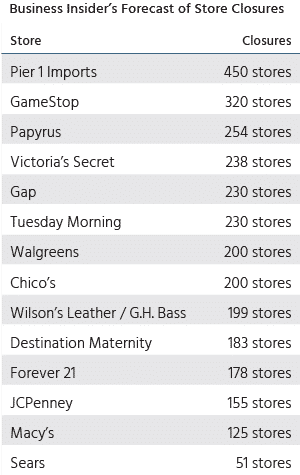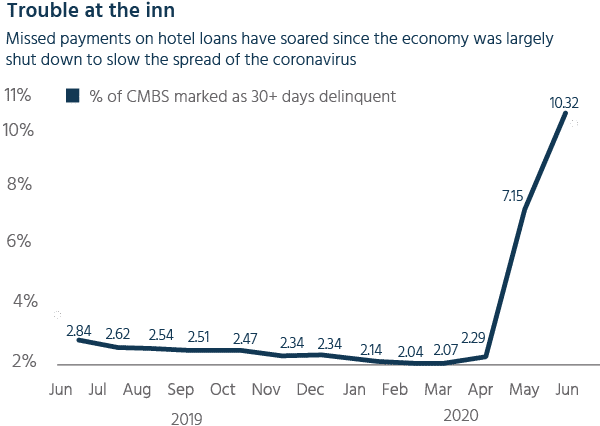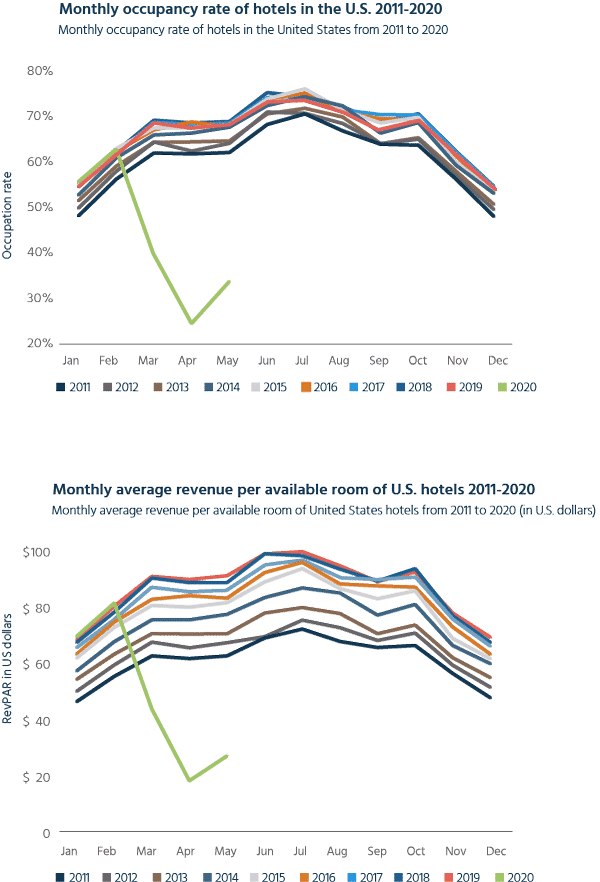Over the last 40 years, multifamily has outperformed every other real estate asset class with better overall returns, better risk-adjusted returns, and lower volatility.
The economic impacts of COVID-19 have resulted in a recession not seen since the Great Depression almost a century ago. Here, we’ll provide data to showcase multifamily performance over the last 90 days and the predictions for its ongoing stability.
Apartments May Provide Safety and Stability
Multifamily is resilient, and rent collections have done better than expected since the onset of COVID-19, according to The National Multifamily Housing Council (NMHC), which tracks apartment rent collections nationally and in all major markets.
The press has taken notice, writing articles about rental performance over recent months featuring positive headlines.
“April Rent Collection Better than Expected”
– Rental Housing Journal, April 22, 2020 (link)“May Rents Surpass Expectations”
– Mortgage Professional America, May 10, 2020 (link)
Each month of collections has tracked higher than the previous months. The graph below shows rent collections during the first two weeks of the month for April, May, June, and July 2020. Included are the 2019 numbers for comparison
.
Source: NMHC Rent Payment Tracker. Available at: https://www.nmhc.org/research-insight/nmhc-rent-payment-tracker/
This next graph shows the full month’s rent collections for April, May, and June 2019 compared to the same months in 2020. The data is clear. Rent collection for apartments has remained strong even in the face of COVID-19.
![]()
Source: NMHC Rent Payment Tracker. Available at: https://www.nmhc.org/research-insight/nmhc-rent-payment-tracker/
It’s a testament to the strength of this asset class and the evergreen nature of shelter. This sentiment is echoed by Doug Bibby, President of NMHC.
“These are trying times for the country, and we are reminded on a regular basis how crucial safe and secure housing is during a period of uncertainty and upheaval…”
– Doug Bibby, President, NMHC
With the resilience of multifamily shining through, one has to wonder how the other commercial real estate asset classes are performing.
Retail
Prior to COVID-19, the retail industry faced stiff headwinds as society has widely embraced e-commerce and online shopping. The Amazon effect, as it’s become known, has eroded the foundation of traditional brick and mortar retail businesses.
The financial services firm UBS authored a report in which they estimate that the U.S. will lose 100,000 more retail stores by 2025. That represents a loss of more than 10% of the total retail stores in America in just five years.
2019 was a record year for retail closures in the U.S. with more than 9,300 stores shutting their doors permanently.
And that was before COVID-19.
With the mandatory shuttering of nonessential retail businesses, many believe that closures will go deeper, and the timeline will accelerate.
Just consider these headlines:
“Retail Rent Collection Plunges to 58% in April”
– The Real Deal, May 12, 2020 (link)
“Will the Coronavirus Finish what the Retail Apocalypse Started with Department Stores?”
– The Motley Fool, April 15, 2020 (link)
“The Retail Apocalypse is Accelerating”
– Seeking Alpha, April 7, 2020 (link)
In an article dated June 5, 2020, Business Insider published its forecasted list of additional partial retail closures for 2020.

Hotels and Hospitality
Hotels are dependent upon travel. So it’s no surprise that COVID-19 has been devastating to hotels and the hospitality industry.
The level of disruption in the hospitality industry has led to headlines like:
“Hotel Occupancies Have Cratered. What Happens Next?”
– National Real Estate Investor, April 6, 2020 (link)
“As Hotels Sit Empty, Loan Delinquencies Pile Up”
– American Banker, April 24, 2020 (link)
The research firm Trepp which follows the commercial mortgage-backed securities (CMBS) markets, recently reported that the distressed CMBS mortgages for hotels represented by “in grace period” or “beyond grace period” rose from 1.5% in March to nearly 20% in April.

Source: Trepp (data points are first day of each month). Available at: https://info.trepp.com/hubfs/Trepp%20June%202020%20Delinquency%20Report.pdf
The best way to understand just how much COVID-19 and the travel bans have hurt hotels is to study graphs of U.S. occupancy rates and revenue per available room (RevPar).
While occupancy rates and RevPar collapsed early on in the pandemic, they’re slowly starting to recover. Nevertheless, they have a long way to go to match the performance of 2019 numbers. For example, occupancy rates for the week ending May 30th were 36.6%, and RevPar was $30.34. Those numbers are still down 43.2% and 62.1%, respectively, for the same time period in 2019.
Summer is traditionally the busiest season for the hospitality industry.
And while many cities are starting to relax restrictions, there isn’t a huge appetite for travel in the current climate of COVID-19. In fact, the research firm STR is predicting that the hospitality industry will not return to 20-year performance averages until 2023.

Source: STR Global. Available at: hotelnewsnow.com
Office
COVID-19 emptied most nonessential offices leaving people to work at home. And while many feared that productivity would decline with remote work, the opposite was found.
“New Survey Shows 47% Increase in Productivity: 3 Things You Must Do When Working from Home”
– Forbes, May 20, 2020 (link)
“Working from Home Increases Productivity”
– Business Daily News, March 31, 2020 (link)
“Working at Home Had a Positive Effect on Productivity During the Pandemic, Survey Says”
– USA Today, May 4, 2020 (link)
This has many employers rethinking the traditional office workspace. Whether some of these companies forego physical office space altogether is yet to be seen. Instead, many are renegotiating the terms of their rent.
Lower rent, coupled with productive employees, has kept delinquencies low in the office space. And because office employees have worked from home, and may continue working from home, those companies remained productive.
In the current environment, office has been more stable than retail and hospitality. In the near term, returns will likely be lackluster, but don’t expect large declines either.
The bigger question is, what happens to the office over the long term?
Employers are exploring the long-term benefits of having their employees work from home, given the increased productivity and cost savings.
According to Global Workplace Analytics, a company can save an average of $10,000 per employee per year by reducing its real estate footprint and transitioning to increased levels of telework.
With advantages like that, it’s no wonder why work-from-home is on the rise and may represent a real threat to office real estate in the future.
For example, Facebook recently predicted more than half of their workforce will be working remotely within the next decade, according to a recent New York Times article.
Industrial
Industrial real estate has been the beneficiary of the increase in e-commerce and the opposing decline of brick and mortar retail. As goods and services have become more readily available online, supply chains and distributions networks have demanded an increase in warehouse space.
Unfortunately, tariffs, trade wars, and COVID-19 have resulted in declining imports.
This combination of events has softened some industrial markets, especially those in port cities.
COVID-19 has exposed our over-dependence on foreign manufacturing of essential items like medicines, safety equipment, and other commodities. Should the U.S. pivot to reclaiming those industries, industrial real estate could further benefit.
However, it’s important to remember that consumer spending largely drives the success of industrial real estate, making it sensitive to market cycles.
Additionally, tax regulations, along with changes in state and federal laws, can significantly impact industrial markets.
There is good news for apartment investors
COVID-19 has been a highly asymmetric shock to the global economy.
The good news for apartment investors is that despite this shock, their investments in the basic need for shelter remain strong.
Building on that good news is the May 2020 jobs report, which highlighted the 2.5 million jobs added to the economy.
This positive trend sharply accelerated in June, with the White House reporting an additional 4.8 million jobs being added to the economy.
And as more cities and states open up, further gains in employment is expected.
The COVID-19 economic crisis is by no means over. While we are grateful to see commercial multifamily prove its resilience during unprecedented economic conditions, we will continue to monitor the performance of the commercial multifamily asset class and report our observations back to you.

Source: Bureau of Labor Statistics, Current Employment Statistics survey, June 05, 2020. Data are preliminary.
* denotes significance
Author: 37parallel.com

